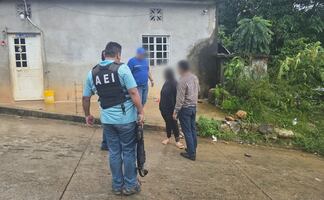Más Información

Posponen en el Senado discusión y votación de reforma para crear la figura de “jueces sin rostro”; se discutirá en febrero

Harfuch descarta que explosión de coche bomba en Michoacán sea un hecho terrorista; "son actos criminales", sostiene

Defensa: 75 funcionarios tienen protección de la Guardia Nacional; hay 500 agentes desplegados en distintas entidades

SESNSP: Baja 37% el promedio diario de homicidios dolosos en 14 meses; 7 estados concentran 51% del total
Many women in Mexico received the same news when they were eight months pregnant: their babies would be born with microcephaly ; to this day, the Health Ministry has not quantified them nor their children.
Almost three years after the first case of Zika was detected in Mexico, the federal agency has reported 51 children who were born with a congenital syndrome associated to the virus; in 43 cases the predominant condition is microcephaly , but many children are not quantified because their mothers were not early diagnosed .
José Luis Alomía
, general director of Epidemiology of the Health Ministry , detailed that until April 8th, 2019 , 12,810 Zika infections have been quantified, out of which 7,120 were pregnant women, and only 51 newborns reported a congenital syndrome, that is, less than 1%.
Although the officer asserted that the Sistem of Epidemiologic Supervision is efficient, he lamented that the window to diagnose a woman with the virus is very short and if not identified during pregnancy, there is no way to know if microcephaly is linked to Zika.
“The mechanisms to identify the disease are limited to certain periods ; women have a span of a month to be studied with serological testing that confirms the exposition to the virus. Also, when a baby is born with a syndrome associated with Zika, samples of its umbilical cord can be taken, but if it’s not done in the first 30 days it is impossible to detect the presence of the virus,” he specified.
Alomía Zegarra
said that beyond the supervision systems of the Health Ministry, there is the possibility that due to a lack of education or knowledge both from patients and employees there are cases left of out of the registries.
Regarding the lack of reagents for Zika, the officer said that the studies are done in the National Network of State Laboratories ; in first-level hospitals, they only take the samples that are sent to the state laboratory to determine whether a woman has the virus or not.
“Due to its kind of analytical framework , the samples must be checked by highly trained chemists and biologists with special equipment for molecular biology and serology; they are not even performed in high-specialty hospitals. Most of them, I would say that 98% of hospitals that attend pregnant women are first-level units; these studies are not made there, they only take the samples and send them to a state laboratory. What I can guarantee is that the 32 laboratories in the country have a sample matrix.”
According to the information requested via transparency, the cost of the studies performed by the Institute of Epidemiological Diagnosis and Reference (Indre) to detect Zika, the PCR ZIKV/DENV/CHIKV, was of MXN $509 per amplification case and the reactive ELISA ZIKA had a cost of MXN $315.
2016 was the only year when the triplex cases to detect Zika, Chikungunya and Dengue were sent; each had 500 reagents.
“At the beginning of the Zika emergency , the Indre made all the molecular and serological diagnosis studies. Later, state labs were trained and the transfer was made so that they performed the studies. Regarding the division, the consumables were supplied to the states only in 2016 ,” says the document.
The study “Projections of the Infection of Zika Virus, Mexico” published in the newsletter of the World Health Organization , says that the Mexican supervision system for Zika is only based on the confirmed cases and not in the suspected or probable, so the real measure of the epidemic is hidden . “If we see the reports of the Latin American region, it would seem that the Zika jumped to Mexico, and went from Guatemala to Puerto Rico ,” asserted the researcher Mauricio Hernández Ávila.
Regarding the situation, Érika García, one of the mothers affected by undiagnosed Zika, urges health authorities to acknowledge the cases, “we’re not asking for help nor money, but for them to check the number of children with microcephaly related to Zika; we are not a myth. ”
mp
Noticias según tus intereses
[Publicidad]
[Publicidad]












